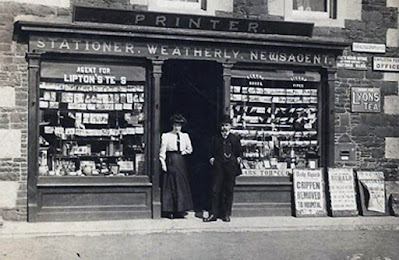I pay little attention to the car in this week’s Sepia Saturday prompt photograph and focus instead on the busy shop window and people standing in the doorway.

This
stationer and newsagent fits the bill in terms of acrowded windows .
In the 1901 census, John P. Weatherly was described as a 40
years old Postmaster of 73 High Street, Earlston,Berwickshire in the
Scottish Borders],
living with his wife, mother-in-law and children. Edward, Ellen and
Margaret. The Trade Directory two years later adds to his role that of
bookseller and printer.
But take a closer look at that newspaper placard outside the shop, which announces that "Crippin Removed to Hospital" - the big clue to dating this image. Dr. Hawley Harvey Crippen, was an American doctor He was hanged 23rd November 1910 in Pentonville Prison, London for the murder of his wife Cora Henrietta Crippen, and was the first criminal to be captured with the aid of wireless telegraphy.


Lochhead's watchmaker & jeweller on Earlston High Street. Look at the right hand window for that unusual term "cyclealities".


Staff at the local Co-operaitve store in Earlston which opened in 1898 
The 1901 census for Earlston lists a William Donaldson, aged 37, a butcher at 43 High Street. with his wife Isabella and sons, John, William and Walter, and daughters Isabella and Helen. Two years later "Slater's Directory for Berwickshire, 1903" lists Walter Donaldson as the butcher.

A crowded shop display in one of the many replica shops to be found at Beamish, the large open air museum. Set in 300 acres, it tells the story of everyday life life in North East England from around 1880 to 1950, with a High Street of houses, shops & trades, vintage trams and buses, a colliery with a pit village, farm, manor house and railway station. More shop interiors below:
**********
Shopping Memories
- Shopping with my mother
in the 1950's in the Home and Colonial Store in Blackpool, Lancashire. No self service of course but wooden
counters all the way around where you waited patiently to be served
by the staff with your groceries. Standards were different then with
the same cutter used for the uncookeed bacon and cooked cold meats.
Food was loose then, not pre-packed. I loved getting a bag of broken
biscuits in Woolworths - and hoped they would include some chocolate
ones.
- My mother was a dressmaker and we often called into a dark haberdashery store which intrigued me, All the walls were
lined with drawers and cupboards, and the staff seemed to know where
everything was.
- Another
fascination was in the stores was with the money placed in little
canisters
travelling back and forth along wires above the
counter to an unseen cashier who sent change back the same way. It is
hard to believe but this was still the method being used in the early
1970s in my local Co-op store.
My father's account, written down in his "Early Life" recalled:
- "Leaving school in 1926,[aged 14] I went to work in a grocer's shop where I had been the Saturday errand boy. I graduated to delivering bags of corn 80lbs plus, with the pony and trap - a Welsh cob called Tommy who was inclined to be lazy. At night I rode him bareback to a field."
I cannot imagine my father on this job, as he never gave the slightest indication of any affinity or interest in horses. Perhaps that experience was enough!









What wonderful photos, and your memories of shopping days. Those businesses were keeping people healthy for many years. And the delivery trucks are also interesting.
ReplyDeleteThe Crippen case is interesting. I’d be a regular at Cadbury’s cocoa.
ReplyDeleteI was intrigued and looked up “cyclealities”. I found this:
ReplyDeleteLucas Cyclealities:
Advert for 'Lucas's Cyclealities' the term used for various pieces of equipment designed for use with cycles of all kinds.
Very interesting! Fantastic window displays in those days!
ReplyDeleteI'm rather fascinated by country shop museums/replicas with all their paraphernalia. (I went with the shop theme in my post this week as well, as there are shop owners in my family history too.)
ReplyDeleteThis was a fine tour of traditional shops. When I first visited Britain in the 80s I was impressed by the variety of small specialist shops like butchers, green grocers, haberdashers, etc. that were still operating in small towns and even in London. Sadly on our seasonal returns to Britain these relics of past times have been converted to other kinds of shops, usually for the immigrant communities, but at least they retain the idea of the old independent shopkeeper. I've just returned from a trip to Indiana, passing through numerous small towns, and it's very disturbing that the old main street buildings are boarded up or derelict leaving these communities without any retail shops whatsoever. It's very sad that America has lost its tradition of independent retail and converted to endless franchise brand shops and big chains.
ReplyDeleteA wonderful selection of photos! I remember going to the local shops and grocer in Altamont, N.Y., when visiting my maternal grandmother. And two of my dad's brothers, Owen and Fred (whom I am writing about now), owned a neighborhood store like these in Holland Patent, N.Y. Now the big box stores are putting economic pressures on the small mom-and-pop shops, which is a shame. Thanks for mentioning the pneumatic tubes. I was fascinated by those in some of our larger department stores.
ReplyDeleteWhat a wonderful post full of everything old fashioned. The town of Columbia is just north of Sonora and the old main street has been renovated & preserved as a State Park (Columbia State Park) & on occasion I've meandered through the old street going in & out of recreated shops of yore - imagining myself shopping there 100+ years ago.
ReplyDeleteGreat blog
ReplyDeletePlease read my post
ReplyDelete